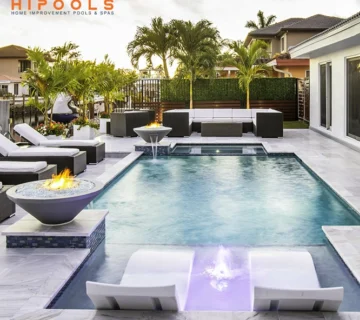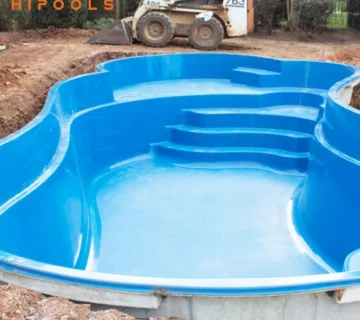A swimming pool transforms your backyard into a private retreat, but understanding the full scope of installation costs is crucial to avoiding sticker shock. From materials and labor to permits and hidden fees, the price of a pool varies widely based on design choices, location, and contractor expertise. In this guide, we break down the costs of popular pool types, explore financing solutions, and share tips to maximize your investment—including how Hi Poolss Company simplifies budgeting with free, no-pressure estimates.

Breaking Down Pool Installation Costs by Type
1. Concrete Pools: The Premium Customizable Option ($50,000–$100,000+)
Concrete pools are the go-to for homeowners seeking limitless design freedom. Whether you envision a lagoon-style pool with a vanishing edge or a classic rectangular design, concrete can accommodate intricate shapes, depths, and finishes like exposed aggregate or glass tile. However, the custom work comes at a cost: installation typically takes 3–6 months due to curing times, and long-term maintenance (acid washing, resurfacing every 10–15 years) adds to the lifetime expense.
2. Fiberglass Pools: Speed and Simplicity ($30,000–$60,000)
Fiberglass pools arrive as pre-manufactured shells, drastically reducing installation time to 2–4 weeks. Their smooth, gel-coated surface resists algae and requires less chemicals, saving you time and money on upkeep. The downside? Limited shapes and sizes—most manufacturers offer 50–100 templates. Still, for homeowners prioritizing quick installation and low maintenance, fiberglass is a crowd-pleaser.
3. Vinyl-Liner Pools: Budget-Friendly Starter Pools ($25,000–$45,000)
Vinyl-liner pools are the most affordable upfront, with soft, customizable liners available in various patterns. However, the liners degrade over time due to UV exposure and chemical wear, requiring replacement every 7–10 years at a cost of $3,000–$5,000. While initial installation is quick (1–3 weeks), the recurring expense makes them less economical over decades compared to concrete or fiberglass.
Note Tip: Regional factors like soil type (rocky terrain requires costly excavation) and local permit fees can add $5,000–$15,000 to your total. Always factor in site preparation!
Financing Your Dream Pool: Smart Strategies
Financing a pool installation is a significant step, but several strategies can make it manageable and tailored to your financial situation. Home equity loans or lines of credit (HELOCs) are a popular choice for homeowners with substantial equity. These options offer competitive interest rates (typically 4–6%) and often include tax-deductible interest, making them ideal for large-scale projects. By spreading repayments over 10–20 years, you can enjoy your pool without straining your monthly budget.
Another flexible route is leveraging contractor financing partnerships. Companies like Hi Poolss Company collaborate with lenders to provide promotional deals, such as 0% APR for 12–24 months, which ease upfront costs. While these plans are attractive, they require discipline: deferred interest clauses mean unpaid balances could retroactively accrue high rates after the promotional period. Always review terms carefully to avoid surprises.
For smaller projects or short-term needs, personal loans (6–12% APR) or 0% intro APR credit cards offer quick access to funds. Personal loans provide predictable payments, while introductory credit card rates can cover initial expenses interest-free—if paid off within the promotional window. However, avoid high-interest cards for large balances, as compounding rates can quickly escalate debt. By aligning your financing choice with your project’s scope and timeline, you’ll ensure your backyard oasis enhances your life without financial stress.
Hidden Costs to Watch For
Even with a detailed quote, unexpected expenses can catch homeowners off guard. Soil testing and remediation is a common surprise, especially in areas with rocky or unstable terrain. If excavation uncovers boulders, dense clay, or poor drainage, you may need grading, retaining walls, or specialized equipment, adding $2,000–$10,000 to your budget. Skipping this step risks structural issues, making it a non-negotiable investment for long-term stability.
Safety features are another often-overlooked expense. Many states legally require fencing, self-locking gates, pool covers, or alarms to prevent accidents, particularly for homes with children. These mandates can cost $1,500–$5,000 depending on materials and local codes. For example, a glass fence adds elegance but may double the price of a standard aluminum one.
Finally, landscaping and decking are critical for blending your pool into your backyard oasis. While not always included in initial quotes, patios, lighting, pergolas, or lush gardens elevate aesthetics and functionality. Basic concrete decking starts around $5,000, while high-end stonework or outdoor kitchens can exceed $20,000. Prioritize these elements early to avoid budget overflows and ensure a cohesive design.
By anticipating these hidden costs upfront, you’ll sidestep financial stress and create a pool area that’s both safe and stunning.

Maximizing Your Pool Investment: Tips to Avoid Overspending and Boost ROI
A well-planned pool installation isn’t just about upfront costs—it’s about ensuring long-term value for your home and lifestyle. Start by selecting a pool type that balances your budget with durability; for example, while concrete pools have higher initial costs, their 50+ year lifespan often outperforms cheaper vinyl liners that require frequent replacements. Opt for energy-efficient equipment like variable-speed pumps and solar heaters to slash monthly utility bills, and prioritize timeless design features (e.g., geometric shapes or neutral finishes) that appeal to future buyers. Regular maintenance, such as seasonal inspections and prompt leak repairs, prevents minor issues from escalating into costly disasters. Enhance your property’s curb appeal—and resale value—by integrating the pool with hardscaping, lighting, or drought-resistant landscaping. Don’t overlook incentives: some states offer rebates for eco-friendly installations, and energy-efficient upgrades may qualify for tax deductions. Most importantly, partner with a reputable contractor like Hi Poolss Company, who provides transparent pricing, quality craftsmanship, and warranties to protect your investment. By combining smart design, proactive upkeep, and expert guidance, your pool becomes more than a luxury—it’s a strategic asset that elevates your home’s value and enjoyment for decades.
DIY vs. Professional Pool Installation: Weighing the Costs and Risks
Opting for a DIY pool installation might seem like a budget-friendly choice, but the risks often outweigh the short-term savings. While upfront costs for a DIY project appear lower—$15,000–$30,000 for a vinyl or above-ground pool versus $25,000+ for professional installations—hidden expenses quickly add up. Renting excavation equipment, purchasing specialized tools, and correcting mistakes (e.g., improper leveling or plumbing leaks) can inflate your budget by 30–50%. Worse, errors in structural integrity or electrical work pose safety hazards and may violate local building codes, leading to fines or costly retrofits. Professional contractors, like Hi Poolss Company, bring expertise in navigating permits, soil testing, and complex installations, ensuring compliance and durability. They also secure bulk pricing on materials, offer warranties (covering labor and equipment), and mitigate risks like groundwater issues or collapsing walls. While DIY projects demand weeks of labor and a steep learning curve, professionals streamline the process with trained crews and project timelines. Ultimately, the peace of mind, long-term reliability, and resale value offered by a pro-built pool far outweigh the gamble of DIY—especially when hidden costs and legal liabilities loom.
How Hi Poolss Company Takes the Guesswork Out of Budgeting
– Free, No-Obligation Estimates:
– Hi Poolss eliminates financial uncertainty by offering detailed, obligation-free quotes.
– This empowers homeowners to explore options without pressure or hidden commitments.
– Site Inspections:
– Experts assess soil stability, terrain slope, and site accessibility to flag potential challenges early.
– Proactive evaluations prevent costly mid-project surprises, like unexpected excavation fees.
– Transparent Breakdowns:
– Quotes itemize material costs, labor fees, permits, and equipment to ensure full visibility.
– Clients see exactly where their money goes, avoiding vague or inflated line items.
– Custom Financing Plans:
– Tailored solutions (e.g., 0% APR for 12–24 months) align with your financial capacity.
– Flexible payment structures make luxury pools accessible without straining budgets.
– Cost-Saving Consultation Tips:
– Hi Poolss advises on energy-efficient pumps or off-peak scheduling to reduce long-term expenses.
– These strategies optimize upfront and recurring costs, maximizing your investment.
Plan Smart, Swim Happy
A pool is a significant investment, but with careful planning, it can enhance your home’s value and your quality of life for decades. Prioritize contractors who provide clarity, like Hi Poolss Company, and always opt for detailed, itemized quotes. Ready to take the plunge?
📞 Contact Hi Poolss Company today for your free estimate and discover how to bring your dream pool to life—without breaking the bank!




No comment